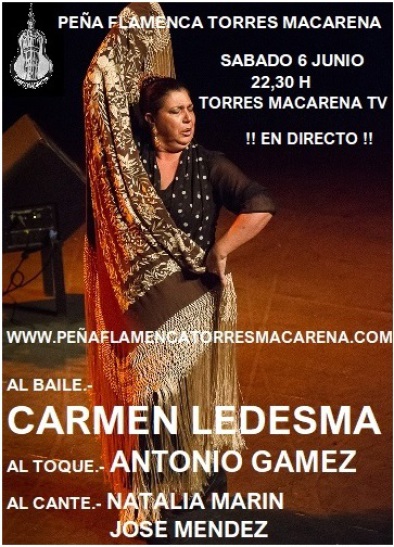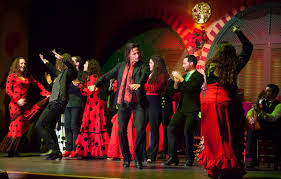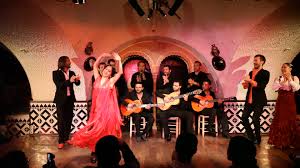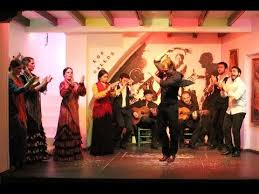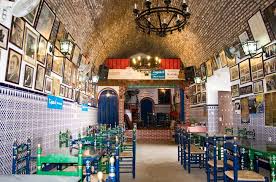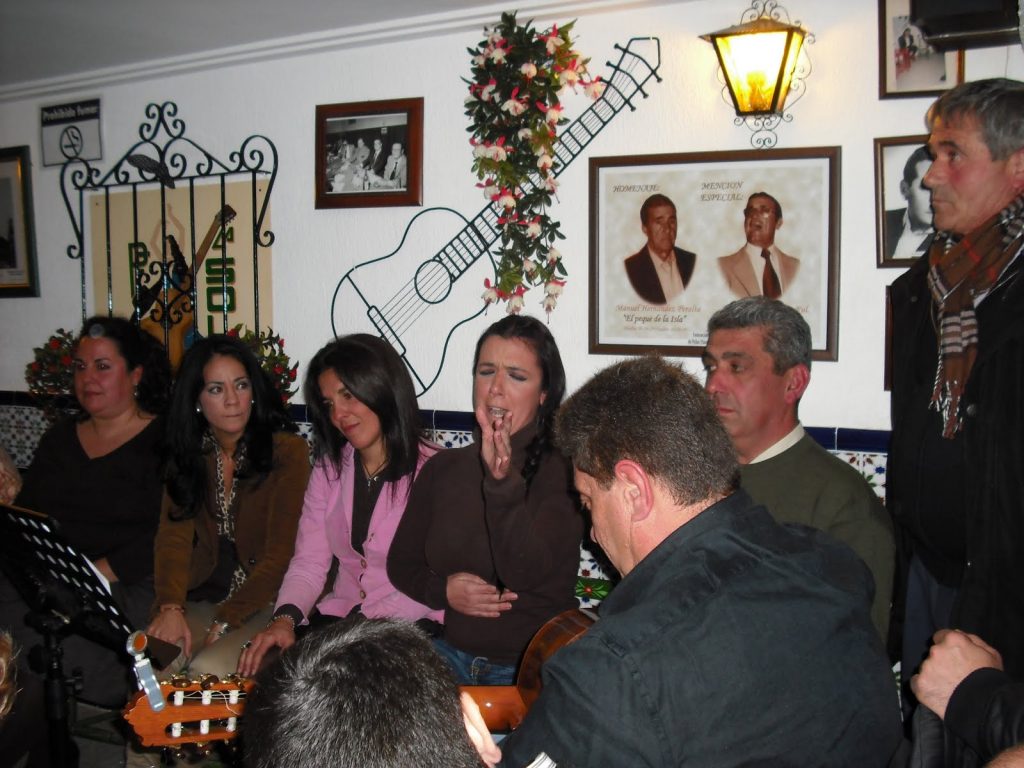Live streaming of a performance direct from Seville, Saturday June 6
In this post we would like to share with you a the link for a live streaming of a flamenco performance that will be taking place tomorrow Saturday June 6 at 10:30 pm (Spanish time) [2:30 pm in Calgary]. Please find the link to the performance at the bottom of the post
Before we look at the performance specifics, we would like to take the opportunity to explain something about the venue where the performance will take place. If you have never been to Spain and never heard of a Peña Flamenco, here is a bit about flamenco culture…
What is the Difference between the main venues of flamenco and especially between a Tablao Flamenco and a Peña Flamenca?
Besides the fact that Tablao is a masculine noun and Peña a feminine noun, there are important differences between these two venues of flamenco especially with regards to their function in the flamenco culture. On first impression and to the unexperienced viewer they are similar, particularly in the fact that they both can have an intimate feel to them and decorated with Andalusian motifs.
As an aside, for those that have attended our shows in Calgary, our flamencocalgary performances have traditionally been tablao style since they are presented in an intimate setting much the same as what you would find in Spain and they are open to the general public to enjoy.
A tablao differ from a theatre both in size and the dynamic of the performance. In Spain, performers are hired to do tablao performances with other artists without much rehearsal time, and therefore rely more on following traditional codes of performance where a dance or a musical piece can be put together on the fly with a lot of on the spot improvisation. Theatres, on the contrary, usually present elaborate and complex choreographed shows.
Now back to the Tablao versus Peña performances…
Tablaos Flamencos
A tablao flamenco is usually a small and intimate venue where flamenco shows take place. The venue is set up in such a way as to maximize the enjoyment of the audience. ‘Tablaos’ are named after the tablao (the wooden platform) on which the artists perform. The wooden surface provides the ideal sound for the ‘zapateado’ – the percussive footwork – and helps protect the joints of the dancers.
In the flamenco tablao the dance and the cante are linked in perfect harmony usually offering the public a flamenco in its purest and most authentic state. For this very reason, these spaces are also known as ‘flamenco temples’, given their contribution to the recovery and maintenance of this Andalusian art throughout its history.
Although it seems that the tablao flamenco has always existed, its origin is in fact relatively recent, when considering the long history of flamenco. The first tablaos began to emerge in the middle of the 20th century replacing the old Cafés Cantantes – singing cafés. These cafés were meeting places for artists and were the first places to offer flamenco shows open to the general public, given that until then flamenco had been restricted to family celebrations or impromptu performances in taverns and bars.
The Cafés Cantantes were found mainly in Cadiz, Seville and Madrid, although they spread all over Spain. These first tablaos served as a springboard for the most important artists and stars of the the flamenco world. It can be said that the great figures of this art have gone through some of the most famous and important tablaos, serving as a learning and subsequent leap to fame.
From 1910, the Cafés Cantante began to disappear and turned into other businesses, which were later replaced by the tablao flamenco we know nowadays. In the 60’s the tablao reached its peak, a time when flamenco also became a universal art with Andalusia being its main point of reference.
Peñas Flamencas
The Peñas Flamencas are associations with regular membership, where presidents are elected and programs are organized to raise funds to meet the needs of running the association. This is the literal definition of the term. In reality a Peña brings together all those who are looking to share the love and spirit of this art form. In Spain, these associations are set up in various types of less formal venues ranging from basement spaces with a few chairs to large buildings that are either privately or publicly funded.
A common denominator amongst all Peñas is the decoration. They all have a tablao (the wooden raised floor for dancing) regardless of the limited venue space; high-back wicker seats, typical in Andalusia, arranged around colorfully and festively decorated tables that are arranged in such a way in order to optimize the viewing of the tablao; the walls are covered with trophies and photos of artists that have come or performed in the Peña, as well as flamenco inspired paintings and posters. The Peñas are attended by its members that are looking to meet up with other aficionados and to carry discussions and talks about singers, virtuoso guitarists, history of flamenco, etc., while sipping on a drink or having a tapa. Also, they may hold singing recitals or full out flamenco performances from time to time.
In addition to supporting flamenco culture Peñas offer young people, who want to dedicate themselves to the profession, an opportunity to present themselves in front of an audience to gain confidence in themselves before they become professional performers or before venturing into the international scene.
The Peñas Flamencos play a crucial role in the survival of the art of flamenco in its purest form. They do this by organizing various events such as concerts, record productions, book reviews, and presentations of collections of various types of material that are useful for the on-going research and in-depth study of flamenco. However, more importantly, the Peñas foremost mission is to ensure that the cante (song) remain in its purest form, that it is represented according to traditional canons, and that it is presented live and accompanied by guitar. There are many challenges to this mission, both in and out of Spain; out of Spain especially because of linguistic and cultural differences in understand and presenting the ‘Cante’. To overcome these challenges, the Peñas present flamenco also through dance performances to attract the public and those that are not as versed in the flamenco singing, all with the objective of stimulating a cultural curiosity to encourage people to deepen their knowledge of this particular aspect of the flamenco art. In Europe there are numerous Peñas Flamenco especially in German and France and to some extent in Italy.
Click here to see a comparative table of the 3 major flamenco venues mentioned in this post
The LIVE PERFORMANCE STREAMING
June 6th performance is organized by the famous “Peña Flamenca Torres Macarena” located in Seville in the “la macarena” neighbourhood (barrio) , at the north end of the city centre, and thus the name. Performing at this performance are: dancer Carmen Ledesma, guitarist Antonio Gamez, and singers Natalia Marín and José Méndez.
Please click on the image below to get to the live streaming.
